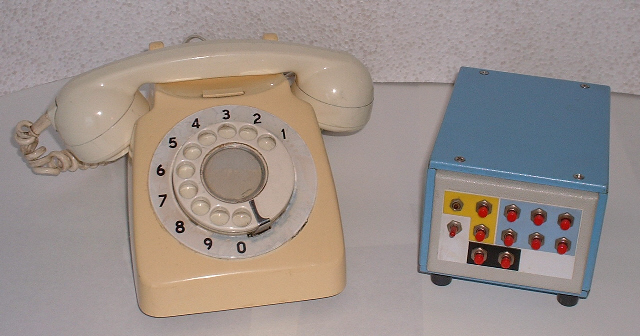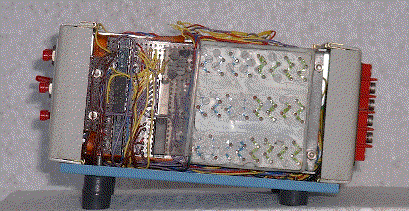Recording Autodialler
Number Store for a Dial Telephone

Back in November 1971 most UK telephones had dials and there was no means to store your frequently dialled numbers and if you dialled and got no answer you had to dial the whole number again if you wanted to have another try.
I had been looking for an 'unofficial' project to do at university and the idea of making a recording autodialler appealed to me, as it would combine my interests in telephones and digital electronics.
A few years earlier and the equipment to do this would have been too large to install alongside a domestic telephone and would have had to go in the exchange. A few years later and it would have been best made using a microprocessor and most of the task would have been the programming. But for now Transistor‑Transistor‑Logic (TTL) was king!
I sketched out a quick design and estimated that I could get it all to fit in a 165 x 114 x 85 mm modular box from West Hyde Developments. I think that was the smallest box in the range and the next largest would have been twice the size. Internally the box is spilt into two by a plain aluminium chassis. The left half contains the power supply and line circuitry while the right half contains the digital electronics comprising forty‑one TTL 'chips'.
This was my first venture into using TTL in any quantity and I took careful heed of the warnings on the data sheets about keeping wires short, particularly 'clock' lines. As a result the 'clock' generator (a transistor multivibrator) was housed on the 'line side' of the box and connected by twisted pair to the 'digital' side. As the 'clock' ran at 1kHz I think I definitely played over-safe, but it would have passed what I later came to know as the "Bert's Buzzer Test" *.
The primary aim of the design was to be able to store a single number dialled on the adjacent telephone, i.e. last-number redial. In order to store a full international Subscriber Dialling (ISD) number it would be necessary to store up to 16 digits but in the event I settled on just storing 10 digits. This was sufficient for UK Subscriber Trunk Dialling (STD). Because the number is stored in a chain of shift registers the limit on the number of stored digits is purely set by the length of the register chain. Given more space and more money the design could have been easily extended.

To give a bit more utility I included a facility to dial out up to six programmed numbers. At the time there was no cheap system of making a non-volatile electronic store. More to prove the principle rather than anything else I produced a diode-store that was programmed by selectively screwing in a set of 8BA screws. The store consisted of two sets of 96 nuts mounted on either side of a circuit board. Inserting a screw connected a pair of nuts on opposite sides of the board. Each nut on the rear of the board has a small diode soldered to it. The whole assembly was potted in silicon rubber on the rear side and filled polyester resin on the top side. The store can hold three numbers of up to 8 digits. Each of the three sub-stores can be split to store two numbers of up to 4 digits. The first arrangement was suitable for storing local call area numbers and the second for use on most PABXs (Private Automatic Branch Exchanges).
The autodialler was designed to be wired in series with the associated telephone. All of the controls are fitted to the front panel. The different functions are indicated by the coloured grounds. Pressing the two switch buttons on the yellow ground together clears the re-dial number store. Pressing the lower button of the pair suspends any dialling operation. Pressing the left button on the black ground enables recording of a number dialled out by the telephone and pressing the right hand button will dial out the stored number. The six buttons on the blue ground control dialling out from the diode matrix. A toggle switch turns the autodialler on and off. The autodialler only needs to be powered up when it is necessary to retain a number in the re-dial store. With the power off operation of the telephone is unaffected.
Note: * Bert's Buzzer Test: Bert King was a technician that worked at the Standard Telephone Company, New Southgate, London. He had an electromagnetic buzzer mounted in a large wooden box with two cotton-covered leads terminating in huge 'crocodile' clips. When we had finished building a bit of kit in the lab we would suspend Bert's Buzzer over it, letting the free-hanging clips clash against each other, causing sparks to fly and the buzzer to sound. If our bit of kit continued to work with no resets or latch-ups it was said to have passed Bert's Buzzer Test and deemed to be immune to any electrical disturbance in the lab. Early EMC testing in fact. My kit always passed and I never had a need to fit a 'reset' button that others found essential.